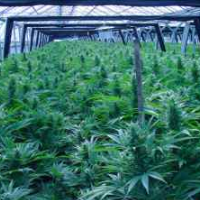Fed Pot Policy Takes Environmental Toll on Unregulated Farms

While medical marijuana dispensaries, blessed by state government, duke it out with U.S. Attorneys enforcing federal pot prohibition laws, growers are having their way with the land unfettered by environmental regulation.
“This is not about marijuana, good or bad,” Humboldt County Supervisor Mark Lovelace told Mother Jones. “This is just about the reality that this one industry, due to prohibition, has been essentially granted immunity from regulation. That's the unintended consequence of federal prohibition.”
The Mendocino County Board of Supervisors took a stab at regulating medical marijuana growing in 2008, levying a plant tax to cover expenses for ensuring compliance with environmental standards. But county officials gutted the ordinance in January after the U.S. Department of Justice wagged a finger at them.
The result is marijuana growers—some out of simple ignorance—divert streams, spread fertilizer and toxic pesticides, grade roads, terrace hillsides, build ponds and ruin habitats of endangered wildlife.
Medical marijuana patches are, by and large, different from the illegal “trespass grows” often controlled by criminal organizations and hidden on public land. Those wreak havoc in the wilderness, but operate outside the law and beyond government reach.
Marijuana headed for dispensaries is legally permitted under state law, found on private land and theoretically could be subject to regulation. But local and state officials are hesitant to pass laws regulating them for fear of being accused by the federal government of officially legitimizing an activity they officially condemn.
Possession and sale of marijuana is illegal under federal law but California legalized medical marijuana with Proposition 215 in 1996 and effectively allowed the opening of storefront dispensaries in 2004. The state also set limits on how much pot patients could cultivate, but the California Supreme Court struck that provision down. Prop. 215 permits medical marijuana users to form collectives for growing marijuana and one grower can gather the doctor certificates from many patients and cultivate pot for them.
The federal government pursued a hands-off policy until October 2011 when U.S. Attorney offices in California began to crack down, closing hundreds of dispensaries. Local, state and federal government, along with the courts, are now all over the map in terms of legal pronouncements and drug enforcement with no coherent policy anywhere in sight.
Alison Sterling Nichols, an adviser to a medical canabis trade group, told Mother Jones she thought medical marijuana growers are by and large sensitive to environmental concerns, but admitted that they would benefit from a better understanding of environmental rules and safeguards.
–Ken Broder
To Learn More:
Medical Pot Growers Hurting California Forest Habitat (by Matt Weiser, Sacramento Bee)
Are California's Pot Farms Bad for the Planet? (by Maggie Caldwell, Mother Jones)
Are California’s Medical Weed Farms Hurting the Environment? (by Whitney Allen, ThinkProgress)
- Top Stories
- Controversies
- Where is the Money Going?
- California and the Nation
- Appointments and Resignations
- Unusual News
- Latest News
- California Forbids U.S. Immigration Agents from Pretending to be Police
- California Lawmakers Urged to Strip “Self-Dealing” Tax Board of Its Duties
- Big Oil’s Grip on California
- Santa Cruz Police See Homeland Security Betrayal in Use of Gang Roundup as Cover for Immigration Raid
- Oil Companies Face Deadline to Stop Polluting California Groundwater





